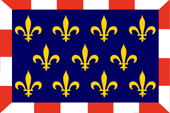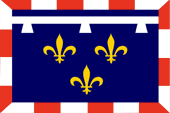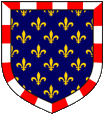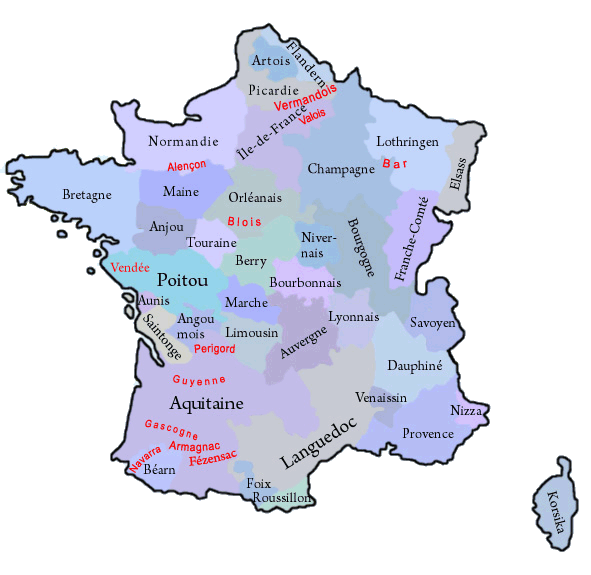mobile View, to the German Version tap the flag


- historical region in today's France
- former county, duchy and province
• Flag
• Meaning/Origin of the Flag
• Coat of Arms
• Meaning/Origin of the Coat of Arms
• Map of the historical Regions in France
• Explanations about the Regions
• History
• Origin of the Country's Name

Flag of Touraine
– Drapeau de la Touraine,
Source, by: Wikipedia (D)




since 1960,
Unofficial flag of the Centre-Val-de-Loire Region
– drapeau officieux de la région Centre-Val-de-Loire,
Source, by: Wikipedia (D)






The flag of the Touraine is a scutcheon-flag, its design is actually the image of the coat of arms of that line of the Valois, which got the Touraine in 1365 as a fiefdom: In 1363 King John II. of France raised the Touraine to a duchy and passes it to his youngest son Philip the Bold (Duke of Burgundy). The since 1960 existing Region of "Centre-Val-de-Loire" uses an unofficial flag, which combines the features of the flags of Orléanais, Berry and of the Touraine.
Source:
Volker Preuß,
Wikipedia (D)


909–1044,
Coat of arms of Blois
– blason de Blois,
Source, by: Wikipedia (D)

1044–1060,
Coat of arms of Anjou
– blason de Anjou,
Source, by: m695.blogspot.com

1060–1150,
Coat of arms of Anjou
– blason de Anjou,
Source, by: m695.blogspot.com

Coat of arms of the House of Plantagenet
– blason de la Maison Plantagenêt,
Source, by:
Wikipedia (D)

1363–1482,
Coat of arms of Touraine
– blason de Touraine,
Source, by:
Wikipedia (D)

Between the years 909 and 1044, the county of Tours belonged to the Counts of Blois. The coat of arms of Blois shows a white oblique-right bar on blue ground, which is bounded above and below by golden lines. From 1044 to 1204/2014, the County of Tours belonged to the Counts of Anjou. The first Counts of Anjou, which go back to Ingelger, showed a blue shield with a red shield-head, topped with a golden three-armed lily cross. When Count Geoffrey II. Martel died in 1060, this line extincted. Successor was his nephew, Geoffrey III., he founded the line of the Counts of Anjou out of the House of Gatinais (later Plantagenets). They first used an a blue shield with a red shield-head, topped with a golden lion. Then the heraldry of Anjou was determinated by the line of the Plantagenet, on the one hand with the six golden lions on blue, on the other hand with the insignia of the Kings of England: two or three golden lions on red. In 1363 King John II. of France raised the Touraine to a duchy and passes it to his youngest son Philip the Bold (Duke of Burgundy). The associated Heraldry showed the blue, with golden lilies topped shield of the Capetians, which was surrounded by a red and white border. The progenitor of the line of Valois, Prince Charles (1270–1325, son of King Philipp III.), Count of Valois, Anjou and Maine, took over the coat of arms from Prince John Tristan (1250–1270, Count of Valois, son of King Ludwig IX.). He surrounded the lily arms of the Capetians with a wide red border. The coat of arms of the Capetians showed three golden lilies on blue, but originally was the coat of arms sprinkled with lilies. From 1365 (by others sources 1376), the number of lilies was reduced to three. The lily-symbol is very old, already the Germanic tribe of the Franks has used it. The House of the Capetians has provided the kings of France between 987 and 1328. It goes back to Hugo Capet, son of Hugo the Great, who was electet to the King of France, in 987, after the death of King Ludwig V. from the House of the Carolingians. The Capetians brought out three branch lines which became the Kings of France: Valois 1328–1589, Bourbon 1589–1792 and 1814–1830, and Orléans 1830–1848.
Source:
heraldique.org,
Volker Preuß,
Wikipedia (D)

The historical, French Regions:

in black: governorate and province in 1776,
in red: former county, province oder governorate
Map: Volker Preuß

The until the French Revolution existing provinces (or governorates) have been historically grown structures, which had their roots oftenly in former fiefdoms of the French crown, historic counties and duchies. They oftenly existed for hundreds of years and had preserved regionality (e.g. cultural particularities and regional languages). On the occasion of the French Revolution such phenomena were of course not desirable, and as part of their bloody and violent egalitarianism any regional references were eliminated. Shortly after the French Revolution the provinces were dissolved and France became divided into many départements, which should have approximately the same size and the same status. The départements were named after rivers or mountains, to use never and in no circumstances the name of an old province. However, there was no success in cutting the connections of the people of France to their respective regions, so that administrative regions were re-created in 1960, to have a better control in regional administrative processes. In this way became départements, which were placed in a historical province, administratively grouped to an oftenly historically named region. The resulted structures coincide only approximately with the boundaries of the old provinces. In the strictly centralist France any regionality is avoided, so that even the official flags of these regions mostly look like flags of companies, unloving, unhistorical, technocratic and modernistic, and these flags should not be a subject of any lexical considerations here. Only in a few of that regions, exist official flags which remember the historical models. But, even the existence of these today's regions is douptful, because in 2014 was passed a territorial reform valid from the year 2016, that reduces the number of the existing regions by merging to nearly the half. However, there exist unofficial flags in nearly all of these regions, which should remember the old provinces and the old heraldry.
Wikipedia Link to the regions of France:
click or tap here
FOTW Link to the regions of France:
click or tap here
Source: Flags of the World,
Wikipedia (D),
Volker Preuß

antiquity · settlement by Celtic tribes
52 B.C. · Roman conquest, to the province of Gallia Lugdunensis
5th century A.D. · the territories north of the Loire River belong to the kingdom of the Roman Governor Syagrius, including today's Touraine, south of the Loire to the kingdom of the Visigoths, from 480 conquest of Gaul by the Franks, until 507 (under King Clovis) expansion of the empire to the Atlantic, the Pyrenees and the Alps, the area of today's Touraine comes to the Frankish Empire
511 · death of King Clovis, division of the Frankish Empire by Salic law of succession among his four sons (residences in Paris, Soissons, Orleans, Reims)
550 · administrative division of the kingdom into the kingdoms of Austrasia, Neustria and Burgundy, today's Anjou comes to Neustria, later to the Duchy of Francia
865 · first mention of Duke of "Francia", called Robert the Strong, who is also Count of Tours
880 · at the division of the Frankish Empire (Treaty of Verdun and Ribbemont) was created the West Frankish Kingdom – the later France (including today's Touraine) under a line of the Carolingians, Hugh the Great employs Hardrad as Viscount in Tours
898 · death of Robert the Strong, succession by his brother Robert II. – Fulk I., the Red, son of Ingelger, the later Count of Anjou, is Count of Tours
909 · Fulk I. cedes Tours to Theobald of Blois, the Old, the progenitor of the House of Blois, his son Theobald becomes hereditary Count of Tour
922 · Robert II. calls himself King of France
923 · Robert II. dies in the Battle of Soissons, the inheritance goes to his son Hugo (Hugh) the Great, he wins the battle, but rejects the crown of France
936 · Hugh the Great is guardian of King Louis IV.
942 · Hugo the Great receives Neustria (now Northern France, which includes today's Touraine) and Burgundy
956 · death of Hugh the Great
987 · death of Louis V. (986–987) from the house of the Carolingians, Hugo Capet, son of Hugo the Great was elected to the King of France and becomes the founder of the Capetian dynasty (Kings of France 987–1328), the Counts of Anjou support the king and they rise to a powerful dynasty in the west of today's France and become competitors of the House of Blois
1016 · Count Fulk III . Nerra beats the Counts of Blois in the Battle of Pontlevoy
1044 · Battle of Nouy, Theobald III. of Blois has to cede the Touraine to Anjou
1060 · death of Count Geoffrey II. Martel, he is succeeded by his nephew, Geoffrey III . , The Bearded, he founds the line of the Counts of Anjou out of the House of Gatinais (later Plantagenets)
1204 · Philip Augustus, King of France, conquers Normandy, Anjou, Maine and Touraine (Angevin Empire of the Plantagenets)
1206 · John Lackland renounces the areas north of the Loire
1214 · John Lackland renounces further areas in the Loire area (the Plantagenets still remain as Kings of England until 1485 and they keep some areas in France), Touraine comes to the French crown domain
1328 · death of King Charles IV. (the Fair), extinction of the direct Capetian line, according to Salic Law Count Philip of Valois (Son of Prince Charles of Valois, first cousin of King Charles IV.) came on the French throne (as King Philip VI .), Anjou comes thus to the royal domain (royal possessions), the English king Edward III. lays claim to the throne as a maternal nephew of Charles IV., reason for the "Hundred Years War" (Anglo-French War, 1338–1453), out of the House of Valois came all kings of France from 1328 to 1589
1363 · King John II. of France (House of Valois) raises the Touraine to a duchy and passes it to his youngest son Philip the Bold (Duke Philip II. of Burgundy), the Touraine remains connected to the Duchy of Burgundy
1477 · Mary of Burgundy (daughter of Charles the Bold) marries Maximilian of Austria from the House of Habsburg
1482 · death of Mary of Burgundy, the two year-old daughter of Mary and Maximilian of Austria, Margaret of Austria, is married with the French prince Charles (the later King Charles VIII.), the Duchy of Burgundy, Touraine and other areas come as a dowry to France, the land comes back to the crown, the title of the duke and the country are awarded in the following years as an appanage to royal princes again and again, Burgundy becomes a province
1584 · death of Francis Duke of Alençon and Touraine, brother of King Henry III. of France, the title of the duke and the country will no longer be avarded, the Touraine becomes a province
1776 · the already in the 14th century created governorates of the civil administration of the kingdom of France become committed to a number of 39, and correspond in this way to the number of provinces, in previous years could any provinces be summarized in one governorate
1789 · French Revolution, the governorates (provinces) become abolished, the Touraine is divided into departments (approximately Indre-et-Loire, and a part of the department of Vienne)
1960 · reintroduction of regions in France, the Touraine doesn't play a role, affiliation with the newly created Centre-Val-de-Loire region (capital: Orléans), of course not within the historic boundaries, just by integrating of the departments of Cher, Eure-et-Loir, Indre, Indre-et-Loire, Loir-et-Cher and Loiret, the department of Vienne comes to the region of Poitou-Charentes
Source:
Wikipedia (D),
Meyers Konversationslexikon

The name "Touraine" has its roots in the name of the city of Tours. The city has its name from the Celtic tribe of the Turons, which can be translated with "residents of the water" (Celt. tur = water).
Source: Atlas der wahren Namen,
Volker Preuß


![]()












